FOOD SAVER V3840 User Manual [fr]
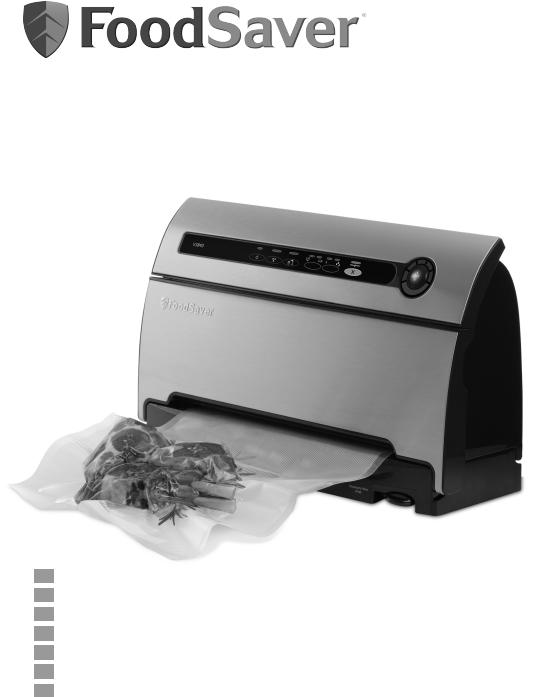
|
|
|
VACUUM SEALING SYSTEM |
VAKUUMVERPACKUNGSSYSTEM |
|
SISTEMA DI CONFEZIONAMENTO SOTTOVUOTO |
VACUÜMVERPAKKINGSSYSTEEM |
|
SYSTÈME D’EMBALLAGE SOUS VIDE |
VAKUUMFÖRSEGLINGSSYSTEM |
|
SISTEMA DE ENVASADO AL VACÍO |
|
|
EN
IT
FR
ES
DE
NL
SW
Reference Guide Guida di riferimento Guide de référence Guía de referencia
Guide de référence Anleitung Handleiding
Referensguide
MODEL • MODELO MODELLO • MODELL MODÈLE • MODELL
MODELL
V3840
www.foodsavereurope.com

Important Safeguards & Tips
Important Safeguards
For your own safety, always follow these basic precautions when using a FoodSaver® appliance:
1.Read the User Manual carefully for operating instructions. Read all instructions in this manual before use.
2.Do not use appliance on wet or hot surfaces, or near a heat source.
3.To protect against electric shock, do not immerse any part of the appliance, power cord or plug in water or other liquid. Unplug from outlet when not in use and before cleaning.
4.To disconnect, unplug power cord from electrical outlet. Do not disconnect by pulling on cord.
5.Do not operate the appliance with a damaged power cord or plug. Do not operate the appliance if it malfunctions or is in any way damaged. Take it to the nearest Authorised Service Centre for examination, repair or electrical or mechanical adjustment.
6.Use appliance only for its intended use.
7.Caution: A short power cord is provided to reduce risks from entanglement or tripping over a longer cord. An extension cord may be used when marked electrical rating is no less than electrical rating of this appliance. All cords should not drape over counter or tabletop where cords can be tripped over or pulled on unintentionally, especially by children.
8.Do not place on or near a hot gas or electric burner, or heated oven. Extreme caution must be used when moving products containing hot liquids.
9.Wait 20 seconds between seals to allow appliance to cool.
10.No user servicing
11.This appliance is not intended for use by persons (including children) with reduced physical, sensory or mental capabilities, or lack of experience and knowledge, unless they have been given supervision or instruction concerning use of the appliance by a person responsible for their safety.
12.Close supervision is necessary when any appliance is used by or near children to ensure they do not play with the appliance.
For Household Use Only
SAVE THESE INSTRUCTIONS
www.foodsavereurope.com |
1 |
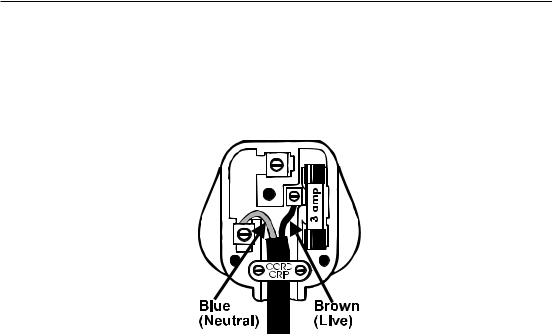
For U.K. and Ireland Only
If the plug is not suitable for the socket outlets in your home, it can be removed and replaced by a plug of the correct type. Please refer to “Installation of a plug” below.
Installation of a plug applicable to U.K. and Ireland.
NOTE: If the terminals in the plug are not marked or if you are unsure or in doubt about the installation of the plug, please contact a qualified electrician. If a 3A 3-pin plug is fitted, it must be an ASTA approved plug, conforming to BS1363 standard.
Replacement 3A fuses must be BSI or ASTA BS1362 approved. The wires in the mains lead are coloured as such:
BROWN - LIVE
BLUE - NEUTRAL
Please note that the colour of these mains wires may not correspond with the colour markings that identify the terminals in your plug.
Please proceed as follows:
The BROWN coloured wire must be connected to the terminal, which is marked with the letter “L” or is coloured RED.
The BLUE coloured wire must be connected to the terminal, which is marked with the letter “N” or is coloured BLACK.
2 |
www.foodsavereurope.com |

Welcome to FoodSaver® Vacuum Sealing System
Congratulations…
You are about to enjoy the freshness benefits of FoodSaver®, The #1 Selling Brand of Vacuum Packaging Systems. For years, the FoodSaver® Vacuum Packaging System has helped millions of households keep food fresh longer in the refrigerator, freezer and pantry. The FoodSaver® system is designed to remove air and extend freshness up to five times longer than conventional storage methods. Keep your FoodSaver® appliance on your worktop, and you will soon discover its convenience and versatility.
Why Vacuum Package?
Exposure to air causes food to lose nutrition and flavour, and also causes freezer burn and enables bacteria, mould and yeast to grow. The FoodSaver® vacuum packaging system removes air and seals in flavour and quality. With a full line of FoodSaver® Bags, Canisters and Accessories to expand your options, you can now enjoy the benefits of a scientifically proven food storage method that keeps food fresh up to five times longer.
The FoodSaver® Vacuum Packaging System Saves
Time and Money.
•Spend less money. With the FoodSaver® system, you can buy in bulk or buy when needed and vacuum package your food in desired portions without wasting food.
•Save more time. Cook ahead for the week, preparing meals and saving them in FoodSaver® Bags.
•Marinate in minutes. Vacuum packaging opens up the pores of food so you can get that greatmarinated flavour in minutes instead of hours.
•Make entertaining a breeze. Make your signature dish and holiday treats in advance so you can spend quality time with your guests.
•Enjoy seasonal or specialty foods. Keep highly perishable or infrequently used items fresh longer.
•Control portions for dieting. Vacuum package sensible portions and write calories and/or fat content on the bag.
•Protect non-food items. Keep camping and boating supplies dry and organised for outings. Protect polished silver from tarnishing by minimising exposure to air.
Do not return this product to place of purchase.
www.foodsavereurope.com |
3 |

Features of Your FoodSaver® Appliance
A. Controls and Indicator Lights
To indicate current setting, vacuum progress and for added control.
B. Vacuum Progress Display
Blue lights signal progression of vacuuming and sealing process. All lights extinguish when the full process is finished.
C. Seal Button
Crush Free Instant Seal feature.
Prevents crushing delicate items.
D. Appliance Door
Opens to access Built-in Roll Holder
and Cutter.
E. Vacuum Channel
Simply insert bag and the FoodSaver® appliance does the rest.
 F. Retractable Accessory Hose/ Accessory Port
F. Retractable Accessory Hose/ Accessory Port
Accessory hose can be used with all FoodSaver® Brand Accessories.
4 |
www.foodsavereurope.com |
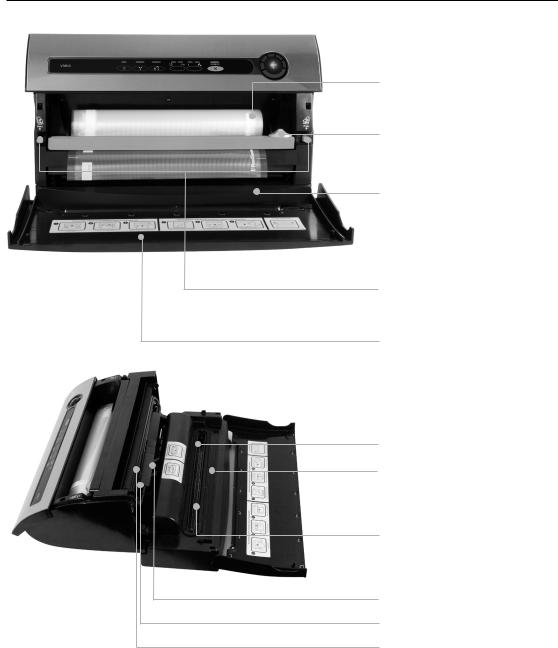
Features of Your FoodSaver® Appliance
G. Built-in Roll Holder
For storage of FoodSaver®
Vacuum Sealing Rolls.
H. Roll Cutter Bar
Simplifies making custom-sized bags.
I. Auto Bag Sensing
Simply insert open end of bag into the vacuum channel and the machine will sense and grasp the bag, vacuum, seal and shut-off automatically.
J. Release Buttons
To open appliance for cleaning.
K. Appliance Door
Opens to access Built-in
Roll Holder and Cutter.
L. Lower Gasket (glued)
M. Extra-wide Sealing Strip with Non-stick Coating
Provides extra secure, airtight seal that’s two times wider.
N. Drip Tray
Catches overflow liquids and contains Food Sensors to detect liquid.
O. Upper Bag Detection Tray
P. Upper Gasket (glued)
Q. Rubber Seal Profile
www.foodsavereurope.com |
5 |
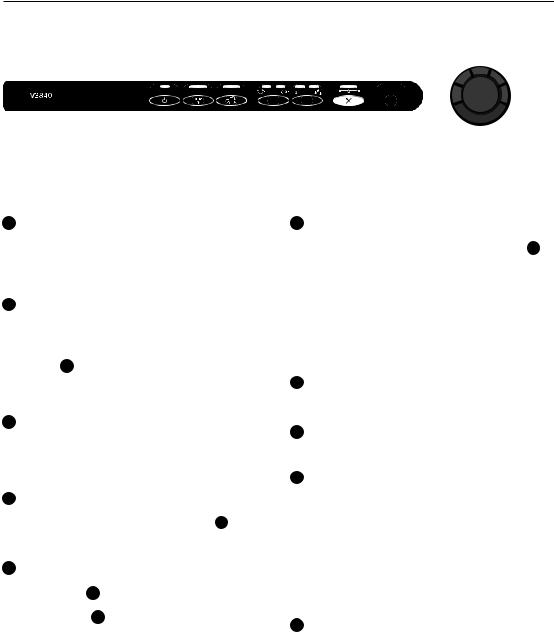
Features of Your FoodSaver® Appliance
|
|
|
|
|
|
|
|
|
|
|
|
|
|
|
|
8 |
|
|
|
|
|
|
|
Indicator |
|
|
2 |
|
|
Seal |
|||||||||
|
|
|
|
|
|
|
|
Button |
|||||||||||
|
|
|
|
|
|
|
|
|
Tray Full |
||||||||||
|
|
|
|
LEDs |
|
|
|
|
|
||||||||||
|
|
|
|
|
|
|
|
|
|
|
|
|
|||||||
|
|
|
|
|
|
|
|
|
|
|
|
Indicator |
|
9 |
|||||
|
|
|
|
|
|
|
|
|
|
|
|
|
|
|
|
|
|
|
Vacuum |
|
|
|
|
|
|
|
|
|
|
|
|
|
|
|
|
|
|||
|
|
|
|
|
|
|
|
|
|
|
|
|
|
|
|
|
|
|
Progress |
|
|
|
|
|
|
|
|
|
|
|
|
|
|
|
|
|
|
|
Display |
|
|
|
|
|
|
|
|
|
|
|
|
|
|
|
|
|
|
||
|
|
|
|
|
|
|
|
|
|
|
|
|
|
|
|
|
|
|
|
Power Button |
|
Marinate Accessory |
Speed |
Adjustable |
Cancel |
|
|
|
|
||||||||||
1 |
|
Button |
Button |
Settings |
Food Settings Button |
Seal Indicator |
|||||||||||||
|
3 |
|
4 |
|
5 |
6 |
|
7 |
|
||||||||||
|
|
|
|
|
|
10 |
|
|
|||||||||||
|
|
|
|
|
|
|
|
|
|
|
|
|
|
|
|
|
|
||
1POWER BUTTON
Press the power button to begin. The Power Indicator, Speed Indicator and Food Indicator lights will become illuminated. After Vacuum Sealing, press the Power Button to turn the appliance Off. Note: After 12 minutes, the appliance will turn Off automatically.
2TRAY FULL INDICATOR LIGHT
During the vacuum sealing process, small amounts of liquids, crumbs or food particles can be inadvertently pulled into the Drip Tray (N). When excess liquid fills the Drip Tray, the unit will turn off and the Tray Full Indicator 2 will activate. To resume normal operation, remove the Drip Tray, empty liquid, wash in warm soapy water or place in top rack of dishwasher. Dry and replace the Drip Tray in trough. (See Care and Cleaning)
3MARINATE BUTTON
A ten-minute predetermined sequence of vacuum pulse to rest ratio-allowing foods to get optimum flavour infusion in the least amount of time. See “Marinating with your FoodSaver®” section on page 10.
4ACCESSORY BUTTON
Press to achieve best vacuum for canisters and accessories. Push Canister Vacuum Button 4 to begin vacuum process. Motor will run until Vacuum Sealing Process is complete.
5SPEED SETTINGS BUTTON
When vacuum sealing delicate items, press the Speed Setting Button 5 so that the gentle speed indicator light is illuminated. For more control you may press the Seal Button 5 at any time to stop the vacuum and begin the automatic the sealing process. Note: Appliance will default to Normal speed upon pressing the Power On Button or when power has been interrupted.
6ADJUSTABLE FOOD SETTINGS BUTTON
For optimal vacuuming and sealing of moist or juicy foods, press the Adjustable Food Setting Button 6 until the Moist Indicator Light is illuminated. Choose the dry food setting for foods without liquid.
The Moist Food Indicator light will flash when Food Sealing Sensors automatically detect any moisture or liquid in the Drip Tray (N). Note: Appliance will default to Dry setting upon pressing the Power Button or when power has been interrupted, unless liquid is detected in the Drip Tray. (See Care and Cleaning section of this User Manual).
7CANCEL BUTTON
Immediately halts the current function opening the Vacuum Channel.
8VACUUM PROGRESS DISPLAY
Displays vacuum levels as the bag/canister is evacuated.
9SEAL BUTTON
Crush Free Instant Seal feature-
This button has four uses:
1.Press to immediately stop the vacuum process and begin sealing the bag. This prevents crushing delicate items such as bread, biscuits and pastries.
2.Press to create a seal when making bags from a FoodSaver® Roll.
3.Press to create a seal on most Mylar bags (such as a potato crisp bag) to keep food sealed airtight.
10SEAL INDICATOR LIGHT
Constant Red light indicates sealing process is engaged. (Flashing light indicates error)
6 |
www.foodsavereurope.com |
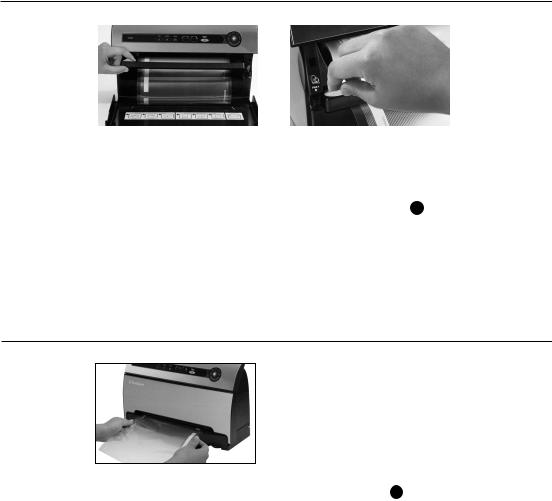
How to Make a Bag from a
FoodSaver® Vacuum Sealing Roll
LIFT ROLL CUTTER |
|
SLIDE CUTTER |
|
|
|
Fig. 1
1.Open the appliance door and place the roll into the Roll Storage Compartment (K). For Best results, insert the roll with material flap down. Note: Bags can be sealed with the appliance door either open or closed.
2.Lift up the Roll Cutter Bar (H) and place bag material beneath the cutter bar (See Fig.1).
3.Pull out enough bag material to hold the item being vacuum packed, plus 4 inches (10 cm). Lower the Cutter Bar and slide the Roll Cutter (H) across the Cutter Bar (See Fig.2).
Fig. 2
4.Press the Seal Button (C). The red seal light will illuminate.
5.Using two hands, insert the open end of the bag into the Vacuum Channel (E) until the clamp motor starts. Bag must be centred between arrows.
6.When the red seal light 10 turns off, sealing is complete. You may remove the bag from the Vacuum Channel (E).
7.You now have one sealed end.
8.Now you are ready to vacuum seal with your new bag
(See below).
How to Vacuum Seal
with FoodSaver® Vacuum Sealing Bags
INSERT BAG
Fig. 3
1.Begin with a FoodSaver® Vacuum Sealing System Bag (or create a bag as described in the “How to Make a Bag from a Roll” section above).
2.Place item(s) in bag, allowing at least 8 cm (3 inches) of space between bag contents and top of bag.
3.Using two hands, insert open end of bag curl side down into Vacuum Channel (E) until clamp motor starts (See Fig.3). The vacuum progress lights will illuminate.
4.Continue to hold bag until vacuum pump starts. You may now release bag. Note: To prevent crushing delicate items, you may press Seal Button (C) at any time to begin automatic sealing process.
5.When red Seal Light 10 turns off, remove bag. Refrigerate or freeze if needed. (See the safety tips section) Note: Wait at least 20 seconds between seals to allow appliance to properly cool.
www.foodsavereurope.com |
7 |

Guidelines
for Vacuum Packaging
Vacuum Packaging and Food Safety
The vacuum packaging process extends the life of foods by removing most of the air from the sealed container, thereby reducing oxidation, which affects nutritional value, flavour and overall quality. Removing air can also inhibit the growth of microorganisms, which can cause problems under certain conditions:
Mould – Easily identified by its fuzzy characteristic. Mould cannot grow in a low oxygen environment, therefore vacuum packaging can slow the growth of mould.
Yeast – Results in fermentation, which can be identified by smell and taste. Yeast needs water, sugar and a moderate temperature to grow. It can also survive with or without air. Slowing the growth of yeast requires refrigeration, while freezing stops
it completely.
Bacteria – Results in an unpleasant odour, discolouration and/or soft or slimy texture. Under the right conditions, anaerobic bacteria such as Clostridium Botulinum (the organism that causes Botulism) can grow without air and sometimes cannot be detected by smell or taste. Although
it is extremely rare, it can be very dangerous.
To preserve foods safely, it is critical that you maintain low temperatures. You can significantly reduce the growth of microorganisms at temperatures of 4°C (40°F) or below. Freezing at -17°C (0°F) does not
kill microorganisms, but stops them from growing. For long-term storage, always freeze perishable foods that have been vacuum packaged, and keep refrigerated after thawing.
It is important to note that vacuum packaging is NOT a substitute for canning and it cannot reverse the deterioration of foods. It can only slow down the changes in quality. It is difficult to predict how long foods will retain their top-quality flavour, appearance or texture because it depends on the age and condition of the food on the day it was vacuumed packaged.
IMPORTANT: Vacuum packaging is NOT a substitute for refrigeration or freezing. Any perishable foods that require refrigeration must still be refrigerated or frozen after vacuum packaging.
Food Preparation and Reheating Tips
Thawing and Reheating Vacuum Packaged Foods
Always thaw foods in either a refrigerator or microwave — do not thaw perishable foods at room temperature.
To reheat foods in a microwave in a FoodSaver® Bag, always cut the corner of the bag before placing it on a microwave-safe dish. However, to avoid hot spots, do not reheat bone-in meat or greasy foods in microwave within a FoodSaver® Bag. You can also reheat foods in FoodSaver® Bags by placing them in water at a low simmer below 75°C (170°F).
Preparation Guidelines for Meat and Fish:
For best results, pre-freeze meat and fish for 1-2 hours before vacuum packaging in a FoodSaver® Bag. This helps retain the juice and shape, and guarantees a better seal.
If it is not possible to pre-freeze, place a folded paper towel between meat or fish and the top of the bag, but below the seal area. Leave a paper towel in the bag to absorb excess moisture and juices during the vacuum packaging process.
Note: Beef may appear darker after vacuum packaging due to the removal of oxygen. This is not an indication of spoilage.
Preparation Guidelines for Hard Cheeses:
To keep cheese fresh, vacuum package it after each use. Make your FoodSaver® Bag extra long, allowing 2.5 cm (1-inch) of bag material for each time you plan to open and reseal in addition to the 8 cm (3-inch) room you normally leave between the contents and the seal. Simply cut the sealed edge and remove cheese. When you are ready to repackage the cheese, just drop it in the bag and reseal.
IMPORTANT: Due to the risk of anaerobic bacteria, Soft cheeses should never be vacuum packaged. Preparation Guidelines for Vegetables:
Vegetables need to be blanched before vacuum packaging. This process stops the enzyme action that could lead to loss of flavour, colour and texture.
To blanch vegetables, place them in boiling water or in the microwave until they are cooked, but still crisp. Blanching times range from 1 to 2 minutes for leafy greens and peas; 3 to 4 minutes for sugar snap peas, sliced courgettes or broccoli; 5 minutes for carrots; and 7 to 11 minutes for corn on the cob.
After blanching, immerse vegetables in cold water to stop the cooking process. Finally, dry vegetables on a towel before vacuum packaging.
Note: All vegetables (including broccoli, brussels sprouts, cabbage, cauliflower, kale, turnips) naturally emit gases during storage. Therefore, after blanching, they must be only stored in the freezer.
When freezing vegetables, it is best to pre-freeze them for 1-2 hours or until solidly frozen. To freeze
8 |
www.foodsavereurope.com |

Guidelines
for Vacuum Packaging
vegetables in individual servings, first place on a baking sheet and spread them out so they are not touching. This prevents them from freezing together in a block. Once they are frozen, remove
from baking sheet and vacuum package vegetables in a FoodSaver® Bag. After they have been vacuum packaged, return them to the freezer.
IMPORTANT: Due to the risk of anaerobic bacteria, fresh mushrooms, onions, & garlic should never be vacuum packaged.
Preparation Guidelines for Leafy Vegetables:
For best results, use a canister to store leafy vegetables. First wash the vegetables, and then dry with a towel or salad spinner. After they are dried, put them in a FoodSaver® Canister or Container and vacuum package. Store in the refrigerator.
Preparation Guidelines for Fruit:
When freezing soft fruit or berries, it is best to prefreeze them for 1-2 hours or until solidly frozen. To freeze fruit in individual servings, first place on a baking sheet and spread them out so they are not touching. This prevents them from freezing together in a block. Once they are frozen, remove from baking sheet and vacuum package fruit in a FoodSaver® Bag. After they have been vacuum packaged, return them to the freezer.
You can vacuum package portions for baking, or in your favourite combinations for easy fruit salad all year round. If storing in the refrigerator, we
recommend using a FoodSaver® Canister or Container.
Preparation Guidelines for Baked Goods:
To vacuum package soft or airy baked goods, we recommend using a FoodSaver® Canister or Container so they will hold their shape. If using a bag, pre-freeze for 1-2 hours or until solidly frozen. To save time, make cookie dough, pie shells, whole pies, or mix dry ingredients in advance and vacuum package for later use.
Preparation Guidelines for Coffee and Powdery Foods:
To prevent food particles from being drawn into the vacuum pump, place a coffee filter or paper towel at the top of the bag or canister before vacuum packaging. You can also place the food in its original bag inside a FoodSaver® Bag.
Preparation Guidelines for Liquids:
Before you vacuum package liquids such as soup stock, pre-freeze in a casserole dish, loaf tin or ice cube tray until solid. Remove frozen liquid from the pan and vacuum package in a FoodSaver® Bag. You can stack these “frozen bricks” in your freezer. When you’re ready to use, just cut the corner of the bag and place in a dish in microwave or drop into water at a low simmer, below 75°C (170°F).
To vacuum package non-carbonated bottled liquids, you can use a FoodSaver® Bottle Stopper with the original container. Remember to leave at least 2.5 cm (1 inch) of room between the contents and the bottom of the Bottle Stopper. You can re-seal bottles after each use.
Preparation Guidelines for Make-ahead Meals, Leftovers and Sandwiches:
Efficiently store your make-ahead meals, leftovers and sandwiches in the stackable, lightweight FoodSaver® containers. They are microwaveable, top rack dishwasher safe and come with a custom adaptor. The lightweight containers will be ready to go to the office or school when you are!
Preparation Guidelines for Snack Foods:
Your snack foods will maintain their freshness longer when you vacuum package them. For best results, use a FoodSaver® Canister or Container for crushable items like biscuits.
Vacuum Packaging Non-Food Items
The FoodSaver® vacuum packaging system also protects non-food items from oxidation, corrosion and moisture. Simply follow the directions to vacuum package items using FoodSaver® Bags, Canisters, Containers and Accessories.
To vacuum package silver, wrap fork tines in soft cushioning material, such as a paper towel, to avoid puncturing the bag. Your FoodSaver® Bags are ideal for outdoor excursions. For camping and hiking, keep your matches, maps and food dry and compact. To have fresh water for drinking, simply fill a FoodSaver® Bag with ice, seal it and when needed, let the ice pack melt. If you are going sailing or boating, vacuum package your food, film and a dry change of clothes. Just remember to bring scissors or a knife to open the bag. To keep emergency kits safe and dry, vacuum package flares, batteries, torches, matches, candles and other necessities. Your emergency items will stay dry and organised in your home, car or boat.
www.foodsavereurope.com |
9 |

Tips for Successful Vacuum Sealing
General Tips
Tips for Successful Vacuum Sealing
1.Vacuum sealing is NOT a substitute for the heat process of canning. Perishables still need to be refrigerated or frozen.
2.For best results, use FoodSaver® brand Bags, Canisters, Containers and Accessories.
3.During the vacuum sealing process, small amounts of liquids, crumbs or food particles can be pulled inadvertently into the Drip Tray (O), clogging the pump and damaging your appliance.
To prevent this, follow these tips:
a.For moist and juicy foods: Freeze first and avoid overfilling bags. You can also place a folded paper towel inside top of bag, and below the seal area, before vacuum sealing.
b.For soups, sauces and liquids: Freeze first and avoid overfilling bags. Or, use a canister or container in refrigerator.
c.For powdery or fine-grained foods: Avoid overfilling bags or use a canister or container. You can also place a coffee filter or paper towel inside before vacuum packaging.
d.Empty the Drip Tray (N) after each use.
4.To avoid overfilling, always leave at least 8 cm (3 inches) of bag material between the bag contents and the top the of bag. Then leave at least one additional inch of bag material for each time you plan to reuse the bag.
5.Do not create your own side seams for a FoodSaver® brand Bag. Our bags are manufactured with a special side seam, which is sealed all the way to the outer edge.
6.To prevent wrinkles in a seal when vacuum sealing bulky items, gently stretch bag flat while inserting into the vacuum channel and hold until the pump begins.
7.If you are unsure whether your bag was sealed properly, simply reseal the bag.
8.When you are vacuum sealing items with sharp edges (dry spaghetti, silverware, etc.), protect the bag from punctures by wrapping item in soft cushioning material, such as a paper towel. You may want to use a canister or container instead of a bag.
9.When using accessories, remember to leave 2.5 cm (1-inch) of space at top of canister or container.
10.Pre-freeze fruits and blanch vegetables before vacuum sealing for best results. Refer to the Guidelines in the Vacuum Packaging section for more information.
11.If the appliance does not function, or the Seal button
(C) flashes to signal an error:
a.Check the power cord to see if it is firmly plugged into an electrical outlet.
b.Examine the power cord for any damages.
c.See if the electrical outlet is working by plugging in another appliance.
d.Check to be certain that the Upper Bag Detection Tray (O) is properly inserted.
e.Make sure the bag is placed correctly inside the Vacuum Channel (E). (See How to Vacuum Seal with FoodSaver® Vacuum Sealing Bags)
f.Check to ensure the Release Buttons ( J) are properly latched.
g.Check the Foam Gasket (L) around the Drip Tray to make sure it is free from food material and is properly inserted into the gasket channel.
h.Check the Upper Gasket (P) around the Upper Bag Detection Tray (O) to be sure it is free from food material.
i.If overheated, allow the appliance to cool for 20 minutes.
j.For more usage tips visit our website at www.foodsavereurope.com.
Tips on Removing Air from a Bag
Avoid wrinkles when inserting the bag into the Vacuum Channel (E).
Wrinkles in the seal may cause a leakage and allow air to return into the bag. To eliminate any wrinkles while inserting the bag into the vacuum channel (E), hold the bag with two hands gently stretching the bag flat until the vacuum pump begins. If you find wrinkles after sealing the bag, simply cut the bag open and vacuum seal again.
If motor runs for more than 30 seconds without stopping, consider the following:
If you are vacuum sealing with a bag, make sure the bag is properly sealed (See “How to Make a Bag From a Roll”). Check the foam gasket around the Drip Tray to make sure it is free from food material and is properly inserted into the gasket channel.
If vacuum sealing with an accessory, check the Accessory Hose connections to ensure a tight fit.
10 |
www.foodsavereurope.com |

Tips for Successful Vacuum Sealing (continued)
Tips on Sealing a Bag
When making a bag from a roll:
Press the Seal Button (C) before placing the bag material into the Vacuum Channel (E). Once the bag is inserted the Seal process will begin immediately.
Note: If you forget to press the Seal Button (C) before inserting the bag into the Vacuum Channel (E), the vacuum pump will turn on. This is not a problem, simply press the Seal Button to prevent the pump from running continuously,and the sealing process will begin.
How to Prevent moisture or liquid from being pulled into the Drip Tray (N) or getting trapped in the seal:
Either pre-freeze moist food such as raw meat for 1-2 hours before vacuum sealing, or place a folded paper towel between food and the end of the bag to absorb excess liquid. Be sure to leave at least 8 cm (3 inches) between the paper towel and the end of the bag so that the bag seals properly with the paper towel inside and not positioned in the seal area.
Make sure appliance has time to cool down.
Wait at least 20 seconds between seals. Under very heavy usage, the appliance will stop operating to prevent overheating. If it does, wait 20 minutes to allow the appliance to cool down.
Tips on Vacuum Sealing with Accessories
How to prepare FoodSaver® Accessories for
Vacuum packaging
Accessories include FoodSavor Vacuum Packaging Canisters, Containers and Bottle Stoppers.
1.Always leave at least 2.5 cm (1 inch) of space between the contents and the rim.
2.Wipe rim of canister, container or bottle to ensure it is clean and dry.
3.Place lid on canister or container, or place stopper in bottle.
4.For accessories with a large knob on lid, turn knob to Vacuum. Vacuum package using the instructions
below. When the vacuum process is complete, turn the knob to Closed before removing the Accessory Hose.
5.For Accessories without a large knob on the lid, vacuum package using instructions below.
Marinating with your FoodSaver® Appliance
Your FoodSaver® Vacuum Sealing System has a special Quick Marinate Cycle which will last about ten minutes. The vacuum motor will “hold” the vacuum for several minutes then release the vacuum allowing the food to “rest” for 30 seconds. This process will then repeat two more times. This “Pulsing” action of “vacuuming and resting” will allow for quicker marinating. When the Quick Marinate Cycle is completed the appliance will beep to signal marinating is complete.
The FoodSaver® Quick Marinator Canister is the perfect FoodSaver® Accessory for marinating foods. Foods will marinate in minutes when vacuum sealed because the vacuum process opens the pores of the food and absorbs the marinade more quickly.
Important Note: Use the FoodSaver® Quick Marinating Canister with clear lid and large white knob. During the Quick Marinate Cycle, make sure the knob on the accessory lid is set to OPEN. Do not set the knob to Vacuum. The Vacuum position on the knob will allow the Quick Marinating Canister to be used for extending vacuum storage.
1.Prepare enough of your favourite marinade to fully cover food inside a marinating canister. Always leave at least 2.5 cm (1-inch) of space between the contents and the top of the rim.
2.Make sure the rubber gasket underneath the lids as well as the rim of the marinating canister is free from food materials.
3.Make sure the Accessory Hose is securely inserted into the port on the FoodSaver® Quick Marinator lid.
4.Make sure the knob on the accessory lid is set to OPEN.
5.Make sure lid is firmly attached to marinator base.
6.Press the Marinate button on the control panel.
7.Your FoodSaver® Vacuum Sealing System will now begin the Quick Marinate Cycle. The Marinate Indicator Light will flash to indicate the marinating process has begun.
8.During the initial vacuum cycle the Marinate Mode Indicator will illuminate. While Marinating, the Vacuum Progress Display will blink during the Vacuum Hold or Rest Cycle.
9.To preserve food safely, after completing the marinating cycle, the appliance will signal with short beeps to indicate your Quick Marinate Cycle is completed. Press any button to silence the signal. You may now cook or refrigerate your marinated food.
www.foodsavereurope.com |
11 |

Storage Guide
Meat, Cheese, Vegetables, Fruits
|
|
Recommended |
|
|
|
Where |
FoodSaver® |
Storage Life |
Normal |
Foods |
to Store |
Bag/Accessory |
with FoodSaver® |
Storage Life |
Meat |
|
|
|
|
|
|
|
|
|
Beef, Pork, Lamb |
Freezer |
FoodSaver® Bag |
2-3 years |
6 months |
Ground Meat |
Freezer |
FoodSaver® Bag |
1 year |
4 months |
Poultry |
Freezer |
FoodSaver® Bag |
2-3 years |
6 months |
Fish |
Freezer |
FoodSaver® Bag |
2 years |
6 months |
Hard Cheeses ( Do not vacuum package soft cheese ) |
|
|
||
|
|
|
|
|
Cheddar, Swiss |
Refrigerator |
FoodSaver® Bag, |
4-8 months |
1-2 weeks |
|
|
Canister |
|
|
|
|
|
|
|
Parmesan |
Refrigerator |
FoodSaver® Bag, |
4-8 months |
1-2 weeks |
|
|
Canister |
|
|
|
|
|||
Vegetables ( Do not vacuum package fresh mushrooms, onions & garlic ) |
|
|||
|
|
|
|
|
Asparagus |
Freezer |
FoodSaver® Bag |
2-3 years |
8 months |
Broccoli, Cauliflower |
Freezer |
FoodSaver® Bag |
2-3 years |
8 months |
Cabbage, Brussels |
Freezer |
FoodSaver® Bag |
2-3 years |
8 months |
Sprouts |
|
|
|
|
|
|
|
|
|
Corn (cob or kernel) |
Freezer |
FoodSaver® Bag |
2-3 years |
8 months |
Green Beans |
Freezer |
FoodSaver® Bag |
2-3 years |
8 months |
Lettuce, Spinach |
Refrigerator |
FoodSaver® Canister |
2 weeks |
3-6 days |
Mangetout, Sugar |
Freezer |
FoodSaver® Bag |
2-3 years |
8 months |
snap Peas |
|
|
|
|
|
|
|
|
|
Fruits |
|
|
|
|
|
|
|
|
|
Apricots, Plums |
Freezer |
FoodSaver® Bag |
1-3 years |
6-12 months |
Peaches, Nectarines |
Freezer |
FoodSaver® Bag |
1-3 years |
6-12 months |
Softer Berries |
|
|
|
|
|
|
|
|
|
Raspberries, |
Refrigerator |
FoodSaver® Canister |
1 week |
1-3 days |
Blackberries |
|
|
|
|
|
|
|
|
|
Strawberries |
Refrigerator |
FoodSaver® Canister |
1 week |
1-3 days |
Harder Berries |
|
|
|
|
|
|
|
|
|
Blueberries |
Refrigerator |
FoodSaver® Canister |
2 weeks |
3-6 days |
Cranberries |
Refrigerator |
FoodSaver® Canister |
2 weeks |
3-6 days |
12 |
www.foodsavereurope.com |

Baked Goods, Coffee, Snacks and Liquids
|
|
Recommended |
Storage |
|
|
Where |
FoodSaver® |
life with |
Normal |
Foods |
to Store |
Bag/Accessory |
FoodSaver® |
Storage Life |
Baked Goods |
|
|
|
|
|
|
|
|
|
Bagels, Bread, |
Freezer |
FoodSaver® Bag |
1-3 years |
6-12 months |
Pastries |
|
|
|
|
|
|
|
|
|
Nuts |
|
|
|
|
|
|
|
|
|
Almonds, |
Pantry |
FoodSaver® Bag, Canister |
2 years |
6 months |
Peanuts |
|
|
|
|
|
|
|
|
|
Sunflower |
Pantry |
FoodSaver® Bag, Canister |
2 years |
6 months |
Seeds |
|
|
|
|
|
|
|
|
|
Coffee |
|
|
|
|
|
|
|
|
|
Coffee Beans |
Freezer |
FoodSaver® Bag |
2-3 years |
6 months |
Coffee Beans |
Pantry |
FoodSaver® Bag, Canister |
1 year |
3 months |
Ground Coffee |
Freezer |
FoodSaver® Bag |
2 years |
6 months |
Ground Coffee |
Pantry |
FoodSaver® Bag, Canister |
5-6 months |
1 month |
Prepared Liquids |
|
|
|
|
|
|
|
|
|
Sauces, Soups, |
Freezer |
FoodSaver® Bag |
1-2 years |
3-6 months |
Stews |
|
|
|
|
|
|
|
|
|
Bottled Liquids |
|
|
|
|
|
|
|
|
|
Oils |
Pantry |
FoodSaver® Bottle Stopper |
1-11⁄2 years |
5-6 months |
Dry Foods |
|
|
|
|
|
|
|
|
|
Beans, Grains |
Pantry |
FoodSaver® Bag, Canister |
1-2 years |
6 months |
Pasta, Rice |
Pantry |
FoodSaver® Bag, Canister |
1-2 years |
6 months |
Powdery Foods |
|
|
|
|
|
|
|
|
|
Dry Milk |
Pantry |
FoodSaver® Bag, Canister |
1-2 years |
6 months |
Dried Coconut |
Pantry |
FoodSaver® Bag, Canister |
1-2 years |
6 months |
Flour |
Pantry |
FoodSaver® Bag, Canister |
1-2 years |
6 months |
Sugar, Brown |
Pantry |
FoodSaver® Bag, Canister |
1-2 years |
6 months |
Sugar |
|
|
|
|
|
|
|
|
|
Snack Foods |
|
|
|
|
|
|
|
|
|
Crisps |
Pantry |
FoodSaver® Canister |
3-6 weeks |
1-2 weeks |
Biscuits, Crackers |
Pantry |
FoodSaver® Canister |
3-6 weeks |
1-2 weeks |
www.foodsavereurope.com |
13 |
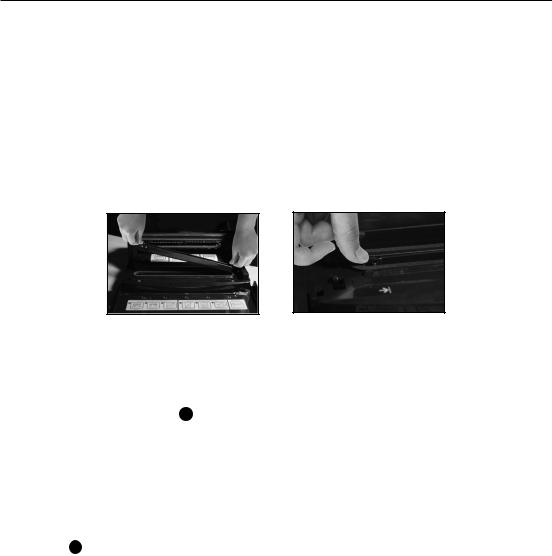
Care and Cleaning
To Clean Appliance:
1.Press the on/off button and unplug before cleaning.
2.Do not immerse in liquid.
3.Open the appliance door (D), while holding the appliance with two hands, press the two Release Buttons (J) with your thumbs, rotate the appliance away from you, and allow the appliance to rest on the counter.
4.Check the Lower Gasket (L) around the Drip Tray (N) and the Upper Gasket (P) which surrounds the Upper Bag Detection Tray (O) to make sure they are free from food materials and that the lower Foam Gasket is properly inserted into gasket channel.
REMOVE FOR CLEANING
Fig. 7
Antibacterial Drip Tray & Upper Bag Detection Tray
Empty the Drip Tray after each use (See Fig. 7). Wash in warm soapy water or place in top rack of dishwasher. The Food Sensors in the Drip Tray (O) will not function correctly if liquid is allowed to remain in the Drip Tray.
This appliance has a Tray Full indicator 2 . When excess liquid fills the Drip Tray, the unit will turn off and the Tray Full Indicator light will activate. To resume normal operation, open the Appliance Door (D), press the two release buttons (K), rotate the appliance away from you, and allow the appliance to rest on the counter. Remove the the Drip Tray, empty liquid, clean the Drip Tray and replace in housing. When replacing drip tray, set the right end of the drip tray into place, then firmly snap the left side down (See Fig. 8). The appliance can be used without the Drip Tray, however the Adjustable Food
Sensor setting 6 will not function without the Drip Tray.
Clean the Upper Bag Detection Tray after each use. The Upper Bag Detection Tray (P) is removable for cleaning, remove by lifting the tabs on each end. Do not pull on the Upper Bag Detection Flags to remove the Upper Bag Detection Tray. Clean the Upper Bag Detection Tray by washing in warm soapy water or placing in top rack of dishwasher. The upper Bag Detection Tray MUST be inserted to use the appliance. Without the Upper Bag Detection Tray, your FoodSaver® Appliance will not detect the bag when inserted in the Vacuum Channel (E). After cleaning, hold the appliance with two hands and rotate upright until the latches lock.
5.Avoid using abrasive products or materials to clean any appliance components. These cleaners can scratch the surface and damage the black foam rubber pads.
6.Use a mild dishwashing soap and a warm, damp cloth to wipe away food residue inside or around components.
7.Dry thoroughly before reusing.
8.If your appliance features
FIRMLY SNAP IN PLACE
Fig. 8
FoodSaver® Accessories
1.Wash all FoodSaver® accessories in warm water, using a mild dishwashing soap. Do not immerse lids in water.
2.Dry thoroughly before reusing.
3.FoodSaver® Canister bases (but not lids) are top rack dishwasher safe. Canister lids should be wiped down with a damp cloth.
4.FoodSaver® Canisters and FoodSaver® Lunch & Leftover and Sandwich & Snack Containers should not be used in the freezer.
5.FoodSaver® Canisters should not be used in the microwave or freezer.
6.FoodSaver® Lunch & Leftover and Sandwich & Snack Containers are microwave and dishwasher safe (top rack only).
14 |
www.foodsavereurope.com |

Troubleshooting
Nothing happens when I try to vacuum package:
1.Check power cord to see if it is firmly plugged into electrical outlet.
2.Examine power cord for damage.
3.Check electrical outlet by plugging in another appliance.
4.If your appliance has latches, make sure the lid is closed and the latch is in the locked position.
5.If your appliance has a mode switch, make sure it is set to the correct mode.
6.Make sure bag is placed correctly down inside the Vacuum Channel.
7.Wait 20 minutes to allow appliance to cool off, and then try using it again.
Note: The appliance will shut off automatically if it becomes too hot.
To keep your appliance from overheating:
Wait at least 20 seconds for the appliance to cool down before you begin vacuum packaging another item. Keep the lid open before vacuum packaging.
Air is still in the bag:
1.Make sure the open end of bag is resting entirely inside the Vacuum Channel. If the edge of bag is beyond the Vacuum Channel, the bag will not seal properly.
2.Examine the bag for leaks. To see if your bag has a leak, seal the bag with air, submerge it into water and apply pressure. Bubbles indicate a leak. Use a new bag if bubbles appear.
3.If you are using a custom-sized FoodSaver® Bag, check the bag’s seal. A wrinkle in the bag along the seal may cause leakage and allow air to re-enter. Just cut the bag and reseal.
4.Do not attempt to make your own side seams for a FoodSaver® Bag. The bags are manufactured with special side seams, which are sealed all the way to the outer edge. Making your own side seams may cause leakage and allow air to re-enter.
5.Make sure the Accessory Hose is not inserted into the Accessory Port.
6.Check the gasket around the Drip Tray and the upper gasket under the lid to make sure it is free from food materials and is properly inserted into the gasket channel.
www.foodsavereurope.com |
15 |

The Complete FoodSaver® System
Get the most out of your FoodSaver® appliance with easy-to-use FoodSaver® Bags, Canisters and
Accessories.
FoodSaver® Bags and Rolls
The design of FoodSaver® Bags and Rolls features
special channels that enable the efficient and complete removal of air. The multi-ply construction makes
them an especially effective barrier to oxygen and moisture, preventing freezer burn. FoodSaver® Bags and Rolls come in a variety of sizes.
IMPORTANT: To avoid possible illness, do not reuse bags after storing raw meats, raw fish or greasy foods. Do not reuse bags that have been microwaved or simmered.
FoodSaver® Vacuum Packaging Canisters
FoodSaver® Canisters are simple to use and ideal for vacuum packaging delicate items such as muffins and other baked goods, liquids and dry goods.
The canisters come in a variety of styles and sizes and can be used on the countertop, in the refrigerator or in the pantry.
The Quick Marinator is an excellent way to marinate foods in minutes instead of hours. Any FoodSaver® Canister can be used for marinating, but we recommend the square or rectangular shapes because less marinade is needed. Canisters should not be used in the freezer.
The stackable, lightweight containers are a convenient option to store make-ahead meals, leftovers and snacks.
Note: Allow hot foods to cool to room temperature before vacuum packaging. Otherwise contents may bubble up out of canister.
FoodSaver® Bottle Stopper
Use FoodSaver® Bottle Stoppers to vacuum package wine, non-carbonated liquids and oils. This will extend the life of the liquid and preserve the flavour. Avoid using the Bottle Stopper on plastic bottles.
Note: Do not vacuum package carbonated or sparkling beverages as gas removal will cause them to go flat.
How to Purchase FoodSaver® Bags, Rolls and Accessories
FoodSaver® products are available at most major retailers.
16 |
www.foodsavereurope.com |

GUARANTEE
Please keep your receipt as this will be required for any claims under this guarantee.
This appliance is guaranteed for 2 years after your purchase as described in this document.
During this guaranteed period, if in the unlikely event the appliance no longer functions due to a design or manufacturing fault, please take it back to the place of purchase, with your till receipt and a copy of this guarantee.
The rights and benefits under this guarantee are additional to your statutory rights, which are not affected by this guarantee. Only Holmes Products (Europe) Ltd. (“Holmes”) has the right to change these terms.
Holmes undertakes within the guarantee period to repair or replace the appliance, or any part of appliance found to be not working properly free of charge provided that:
•you promptly notify the place of purchase or Holmes of the problem; and
•the appliance has not been altered in any way or subjected to damage, misuse, abuse, repair or alteration by a person other than a person authorised by Holmes.
Faults that occur through, improper use, damage, abuse, use with incorrect voltage, acts of nature, events beyond the control of Holmes, repair or alteration by a person other than a person authorised by Holmes or failure to follow instructions for use are not covered by this guarantee. Additionally, normal wear and tear, including, but not limited to, minor discoloration and scratches are not covered by this guarantee.
The rights under this guarantee shall only apply to the original purchaser and shall not extend to commercial or communal use.
If your appliance includes a country-specific guarantee or warranty insert please refer to the terms and conditions of such guarantee or warranty in place of this guarantee or contact your local authorized dealer for more information.
This marking indicates that this product should not be disposed with other household wastes throughout the EU. To prevent possible harm to the environment or human health from uncontrolled waste disposal, recycle it responsibly to promote the sustainable reuse of material resources. To return your used device, please use the return and collection systems or contact the retailer where the product was purchased.
They can take this product for environmental safe recycling.
Holmes Products (Europe) Limited 1 Francis Grove
London SW19 4DT UK
www.foodsavereurope.com |
17 |

Importanti misure di sicurezza
Importanti misure di sicurezza
Per assicurare la propria sicurezza, osservare sempre queste precauzioni di base quando si usa un apparecchio FoodSaver®:
1.Leggere attentamente il manuale dell’utente per le istruzioni di funzionamento. Leggere tutte le istruzioni prima di usare questo manuale.
2.Non usare l’apparecchio su superfici bagnate o bollenti o vicino a una fonte di calore.
3.Per proteggersi da un’elettrocuzione, non immergere alcuna parte dell’apparecchio o del cavo di alimentazione nell’acqua o in altri liquidi.
4.Per disconnettere, staccare il cavo elettrico dalla presa elettrica. Non disconnettere tirando il cavo.
5.Non usare l’apparecchio con un cavo o una presa danneggiati. Non usare l’apparecchio se il funzionamento è difettoso o risulta danneggiato in qualche modo. Portarlo a un Centro di servizio autorizzato per farlo esaminare, riparare o regolare l’alimentazione o la meccanica.
6.Usare l’apparecchio solo per l’uso al quale è destinato.
7.Attenzione: è fornito un cavo di alimentazione corto per ridurre i rischi di attorcigliamento o di disinnesto causati da un cavo più lungo. Si può usare una prolunga quando la taratura indicata non è inferiore alla taratura del cavo di questo apparecchio. Tutti i cavi non devono pendere dal piano di lavoro o dal tavolo per evitare che possano essere inavvertitamente disinnescati o tirati, specialmente dai bambini.
8.Non porre l’apparecchio sopra o nei pressi di un fornello a gas o elettrico acceso o in un
forno caldo. Fare estrema attenzione durante la movimentazione di prodotti contenenti liquidi bollenti.
9.Attendere 20 secondi tra le sigillature per consentire all’apparecchio di raffreddarsi.
10.Nessuna manutenzione è necessaria da parte dell’utente
11.Questo apparecchio non è concepito per l’uso da parte di persone (inclusi i bambini) con capacità fisiche, sensorie o mentali ridotte o che mancano di esperienza o conoscenza, salvo se è stato loro fornita supervisione o istruzione sull’uso dell’apparecchio da parte di una persona responsabile della loro sicurezza.
12.Un’attenta supervisione è necessaria quando un apparecchio è usato da bambini o nelle loro vicinanze per assicurarsi che essi non giochino con l’apparecchio.
Solo per uso domestico
CONSERVARE QUESTE
ISTRUZIONI
www.foodsavereurope.com |
1 |

Benvenuti al sistema di sigillatura sottovuoto Foodsaver®
Congratulazioni…
State per beneficiare dei vantaggi di freschezza del FoodSaver®. Per anni, il sistema di conservazione sottovuoto FoodSaver® ha aiutato milioni di famiglie a mantenere gli alimenti freschi il più a lungo nel frigorifero, nel freezer e nella dispensa. Il sistema FoodSaver® è studiato per rimuovere l’aria e prolungare il tempo di freschezza degli alimenti fino a cinque volte più a lungo dei metodi convenzionali di conservazione. Mantenere l’apparecchio FoodSaver® sul piano di lavoro per scoprirne presto la convenienza e la versatilità.
Non riportare questo prodotto dove è stato acquistato
Perché la conservazione sottovuoto?
L’esposizione all’aria causa la perdita dei valori nutrizionali e del sapore e la bruciatura da freddo e favorisce la crescita di batteri, muffa e fermentazione. Il sistema di conservazione sottovuoto FoodSaver® rimuove l’aria e sigilla il sapore e la qualità. Con una gamma completa di sacchetti, scatole e accessori per ampliare le
opzioni, si può ora beneficiare dei vantaggi di un metodo di conservazione degli alimenti provato scientificamente, che mantiene questi ultimi freschi fino a cinque volte più a lungo del normale.
Il sistema di conservazione sottovuoto FoodSaver® fa risparmiare tempo e denaro.
•Fa spendere meno denaro. Con il sistema FoodSaver®, si può acquistare all’ingrosso o in saldo e conservare gli alimenti nelle porzioni desiderate senza sprechi.
•Fa risparmiare più tempo. Si può cucinare in anticipo per la settimana, preparando le pietanze e conservandole nei sacchetti FoodSaver®.
•Marinatura possibile in pochi minuti. La conservazione sottovuoto apre i pori degli alimenti, in modo che si può ottenere la fragranza di una magnifica marinata in pochi minuti invece che di ore.
•Facilita l’intrattenimento. Si può cucinare il proprio piatto preferito e preparare le festività in anticipo in modo da poter trascorrere tranquillamente il proprio tempo con gli ospiti.
•Consente di apprezzare più a lungo gli alimenti stagionali o speciali. Si mantengono freschi più a lungo gli alimenti deperibili o consumati con minor frequenza.
•Aiuta a controllare le porzioni per le diete.
Si possono conservare sottovuoto porzioni controllate e scrivere sui sacchetti le calorie e/o i grammi di grasso.
•Protegge gli articoli non alimentari. Mantiene gli oggetti per il campeggio o le vacanze in barca asciutti e organizzati per le escursioni . Protegge l’argenteria lucidata dall’annerimento, minimizzando l’esposizione all’aria.
2 |
www.foodsavereurope.com |
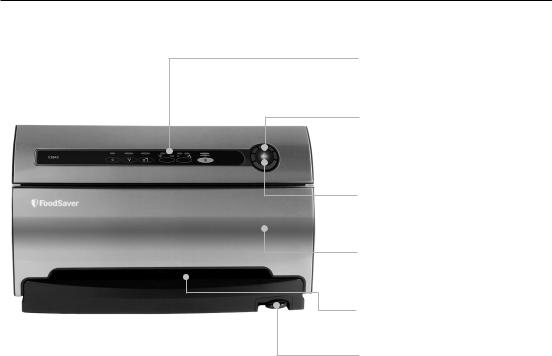
Caratteristiche dell’apparecchio FoodSaver®
A. Controlli e spie
Per indicare le impostazioni attuali, i progressi dell’aspirazione e per un ulteriore controllo.
B. Display della progressione dell’aspirazione
Spie blu segnalano la progressione dell’aspirazione e del processo di sigillatura. Quando tutte le luci si spengono, il processo completo è terminato.
C. Pulsante di sigillatura
Sigillatura istantanea senza schiacciamento. Impedisce lo schiacciamento di articoli delicati.
D.Sportello dell’apparecchio
Si apre per consentire l’accesso al supporto del rotolo e al taglierino incorporati.
E. Canale di aspirazione
Basta inserire il sacchetto e l’apparecchio FoodSaver fa il resto.
F. Tubo flessibile ritraibile/ Porta per gli accessori
Il tubo flessibile degli accessori può essere usato con tutti gli accessori della marca FoodSaver® .
www.foodsavereurope.com |
3 |

Caratteristiche dell’apparecchio FoodSaver®
G.Supporto del rotolo incorporato
Per la conservazione di rotoli di sigillatura sottovuoto del FoodSaver® .
H.Barra di taglio del rotolo
Semplifica la preparazione di sacchetti della dimensione desiderata dal consumatore.
 I. Percezione automatica del sacchetto
I. Percezione automatica del sacchetto
Basta inserire il lato aperto del sacchetto e la macchina avverte e afferra il sacchetto, aspira, sigilla e si arresta automaticamente.
J. Pulsanti di rilascio
Consentono l’apertura dell’apparecchio per la pulizia.
K.Sportello dell’apparecchio
Si apre per consentire l’accesso al supporto del rotolo e al coltello incorporati.
L. Guarnizione inferiore (incollata)
M.Striscia di sigillatura extra ampia con rivestimento non aderente
Assicura una sigillatura ermetica, ultra sicura che è due volte più ampia.
N.Vassoio di gocciolamento
Raccoglie i liquidi che fuoriescono e contiene sensori di alimenti per rilevare la presenza del liquido.
O.Vassoio superiore di rilevazione del sacchetto
P. Guarnizione superiore (incollata)
Q.Profilo del nastro di sigillatura
4 |
www.foodsavereurope.com |
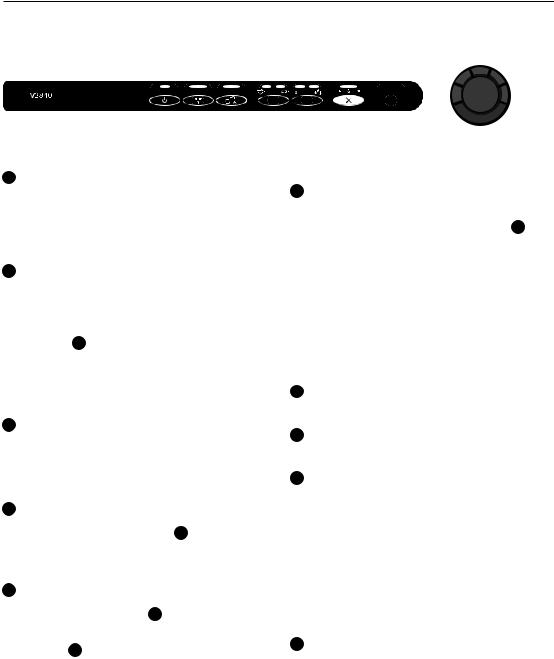
Caratteristiche dell’apparecchio FoodSaver®
|
|
|
|
|
|
|
|
|
|
|
|
|
|
|
|
|
|
|
|
|
8 |
|
|
|
|
|
|
|
|
|
|
|
|
|
|
|
|
|
|
|
|
2 |
|
|
Pulsante di |
|
|
||||
|
|
|
|
|
|
|
|
|
|
|
|
|
|
|
|
|
|
sigillatura |
|
|
|||||
|
|
|
|
|
|
|
LED spia |
|
|
|
|
|
|
Indicatore di |
|
|
|
|
|||||||
|
|
|
|
|
|
|
|
|
|
|
|
|
|
|
|
|
|
|
|
||||||
|
|
|
|
|
|
|
|
|
|
|
|
|
|
|
|
vassoio pieno |
|
|
|
|
|
9 |
|||
|
|
|
|
|
|
|
|
|
|
|
|
|
|
|
|
|
|
|
|
|
|
|
|
|
Display |
|
|
|
|
|
|
|
|
|
|
|
|
|
|
|
|
|
|
|
|
|
|
|
|
||
|
|
|
|
|
|
|
|
|
|
|
|
|
|
|
|
|
|
|
|
|
|
|
|
|
della |
|
|
|
|
|
|
|
|
|
|
|
|
|
|
|
|
|
|
|
|
|
|
|
|
|
|
|
|
|
|
|
|
|
|
|
|
|
|
|
|
|
|
|
|
|
|
|
|
|
|
progressione |
|
|
|
|
|
|
|
|
|
|
|
|
|
|
|
|
|
|
|
|
|
|
|
|
|
|
della |
|
Pulsante di alimentazione |
Pulsante di |
Pulsante per |
Regolazioni |
Impostazione |
Pulsante |
|
|
|
sigillatura |
|||||||||||||||
|
|
|
|
|
|
||||||||||||||||||||
|
marinatura |
|
acessori |
della velocità |
regolabile |
annulla |
|
|
|
|
|
||||||||||||||
|
1 |
|
|
Indicatore della |
|||||||||||||||||||||
|
|
3 |
|
4 |
|
5 |
|
|
|
|
degli alimenti |
7 |
|
||||||||||||
|
|
|
|
|
|
|
|
|
|
|
sigillatura |
||||||||||||||
|
|
|
|
|
|
|
|
|
|
|
|
|
|
||||||||||||
|
|
|
|
|
|
|
|
|
|
|
|
|
|
|
|
6 |
|
|
|||||||
|
|
|
|
|
|
|
|
|
|
|
|
|
|
|
|
|
|
10 |
|
|
|
||||
1 |
PULSANTE DI ALIMENTAZIONE |
|
|
|
|
|
|
|
|
|
|
|
|
|
|
|
|
|
|
||||||
|
|
|
|
|
|
|
|
|
|
|
|
|
|
|
|
|
|
|
|
||||||
|
Premere il pulsante di alimentazione per iniziare |
6 |
PULSANTE DI IMPOSTAZIONE REGOLABILE DEGLI |
||||||||||||||||||||||
|
il processo. La spia di alimentazione, la spia della |
|
|
|
ALIMENTI |
|
|
|
|
|
|
|
|||||||||||||
|
velocità e la spia degli alimenti si accendono. Dopo |
|
|
|
Per l’aspirazione e la sigillatura ottimali della maggior parte |
||||||||||||||||||||
|
la sigillatura sottovuoto, spegnere il pulsante di |
|
|
|
degli alimenti umidi o sugosi, premere il pulsante 6 di |
||||||||||||||||||||
|
alimentazione. Nota: dopo 12 minuti l’apparecchio si |
|
|
|
impostazione regolabile degli alimenti, fino a che la spia |
||||||||||||||||||||
|
spegne automaticamente. |
|
|
|
|
|
|
|
|
|
indicatrice di presenza di umido si accende. |
|
|
||||||||||||
2 |
SPIA DI VASSOIO PIENO |
|
|
|
|
|
|
|
|
|
Scegliere l’impostazione di alimenti secchi per gli alimenti |
||||||||||||||
|
|
|
|
|
|
|
|
|
senza liquidi. La spia di alimenti umidi lampeggia |
|
|
||||||||||||||
|
Durante il processo di sigillatura sottovuoto, piccoli |
|
|
|
|
|
|||||||||||||||||||
|
|
|
|
quando i sensori di sigillatura degli alimenti rilevano |
|||||||||||||||||||||
|
quantitativi di liquidi, briciole o particelle di alimenti |
|
|
|
|||||||||||||||||||||
|
|
|
|
automaticamente qualsiasi umidità o liquido nel vassoio |
|||||||||||||||||||||
|
possono essere inavvertitamente spinti nel vassoio |
|
|
|
|||||||||||||||||||||
|
|
|
|
di gocciolamento(N). Nota: l’impostazione predefinita |
|||||||||||||||||||||
|
di gocciolamento (N). Quando il liquido in eccesso |
|
|
|
|||||||||||||||||||||
|
|
|
|
dell’apparecchio è quella degli alimenti secchi dopo |
|||||||||||||||||||||
|
riempie il vassoio, l’unità si arresta e viene attivato |
|
|
|
|||||||||||||||||||||
|
|
|
|
aver premuto il pulsante di alimentazione o quando |
|||||||||||||||||||||
|
l’indicatore 2 |
di vassoio pieno. Per ripristinare |
|
|
|
||||||||||||||||||||
|
|
|
|
l’alimentazione viene interrotta, salvo se viene rilevato del |
|||||||||||||||||||||
|
il funzionamento normale, rimuovere il vassoio di |
|
|
|
|||||||||||||||||||||
|
|
|
|
liquido nel vassoio di gocciolamento. (Vedere la sezione |
|||||||||||||||||||||
|
gocciolamento, vuotare il liquido, lavarlo con acqua |
|
|
|
|||||||||||||||||||||
|
|
|
|
Cura e Pulizia di questo manuale). |
|
|
|
|
|
||||||||||||||||
|
calda e sapone o porlo nel cestello superiore della |
|
|
|
|
|
|
|
|
||||||||||||||||
|
7 |
|
|
|
|
|
|
|
|
|
|
|
|
|
|||||||||||
|
lavatrice. Asciugare e riporre il vassoio nel condotto. |
PULSANTE ANNULLA |
|
|
|
|
|
||||||||||||||||||
|
(Vedere Cura e Pulizia) |
|
|
|
|
|
|
|
|
|
Arresta immediatamente il funzionamento aprendo il |
||||||||||||||
3 |
PULSANTE DELLA MARINATURA |
|
|
|
|
|
|
|
canale di aspirazione. |
|
|
|
|
|
|||||||||||
|
|
|
|
8 |
DISPLAY DELLA PROGRESSIONE DELL’ASPIRAZIONE |
||||||||||||||||||||
|
Una sequenza predeterminata di dieci minuti di impulsi |
||||||||||||||||||||||||
|
di aspirazione per il riposo-che consente agli alimenti |
|
|
|
Visualizza i livelli di aspirazione mentre l’aria viene |
||||||||||||||||||||
|
di ottenere infusione ottimale di fragranza in un breve |
|
|
|
rimossa dal sacchetto o dalla scatola. |
|
|
||||||||||||||||||
|
periodo di tempo. Vedere la sezione “Marinatura con il |
9 |
PULSANTE DI SIGILLATURA |
|
|
|
|
|
|||||||||||||||||
|
FoodSaver®” a pagina 10. |
|
|
|
|
|
|
|
|
|
|
|
|||||||||||||
|
|
|
|
|
|
|
|
|
|
Sigillatura automatica senza schiacciamento-Questo |
|||||||||||||||
|
|
|
|
|
|
|
|
|
|
|
|
|
|||||||||||||
4 |
PULSANTE PER ACCESSORI |
|
|
|
|
|
|
|
|
|
pulsante ha quattro funzioni |
|
|
|
|
|
|||||||||
|
|
|
|
|
|
|
|
|
1. Premere per arrestare immediatamente il processo |
||||||||||||||||
|
Premere per ottenere la migliore aspirazione per le |
|
|
|
|||||||||||||||||||||
|
scatole e gli accessori. Il pulsante 4 per iniziare il |
|
|
|
|
|
di aspirazione e iniziare la sigillatura del sacchetto. |
||||||||||||||||||
|
processo di aspirazione. Il motore sarà in funzione |
|
|
|
|
|
In tal modo si evita di schiacciare articoli delicati, |
||||||||||||||||||
|
fino al completamento del processo di sigillatura |
|
|
|
|
|
come il pane, i biscotti e la pasticceria. |
|
|
||||||||||||||||
|
sottovuoto. |
|
|
|
|
|
|
|
|
|
|
2. Premere per creare un sigillo quando si fanno i |
|||||||||||||
|
|
|
|
|
|
|
|
|
|
|
|
|
|||||||||||||
5 |
PULSANTE DI REGOLAZIONE DELLA VELOCITÀ |
|
|
|
|
|
sacchetti da un rotolo FoodSaver®. |
|
|
||||||||||||||||
|
|
|
|
|
|
|
|
|
|
|
|
|
|
|
|
||||||||||
|
Quando si esegue la sigillatura sottovuoto di articoli |
|
|
|
3. Premere per creare una sigillatura su sacchetti |
||||||||||||||||||||
|
delicati, premere il pulsante 5 di regolazione della |
|
|
|
|
|
umidi Mylar (come un sacchetto di patatine) per |
||||||||||||||||||
|
velocità, in modo che la spia di velocità ridotta si |
|
|
|
|
|
mantenere il cibo sigillato ermeticamente. |
|
|
||||||||||||||||
|
accende. Per un controllo superiore si può premere |
10 |
SPIA DI SIGILLATURA |
|
|
|
|
|
|||||||||||||||||
|
il pulsante 5 |
di sigillatura in qualsiasi momento |
|
|
|
|
|
||||||||||||||||||
|
|
|
|
Una luce rossa costante indica che il processo di |
|||||||||||||||||||||
|
per arrestare l’aspirazione e iniziare il processo |
|
|
|
|||||||||||||||||||||
|
|
|
|
sigillatura è in corso. (Una luce lampeggiante indica |
|||||||||||||||||||||
|
di sigillatura automatica. Nota: l’impostazione |
|
|
|
|||||||||||||||||||||
|
|
|
|
errore) |
|
|
|
|
|
|
|
||||||||||||||
|
predefinita dell’apparecchio è la velocità normale |
|
|
|
|
|
|
|
|
|
|
||||||||||||||
|
|
|
|
|
|
|
|
|
|
|
|
|
|
|
|
|
|||||||||
|
quando si preme il pulsante di accensione o quando |
|
|
|
|
|
|
|
|
|
|
|
|
|
|
|
|
||||||||
|
l’alimentazione è stata interrotta. |
www.foodsavereurope.com |
|
|
|
|
|
5 |
|||||||||||||||||
|
|
|
|
|
|
|
|
|
|
|
|||||||||||||||
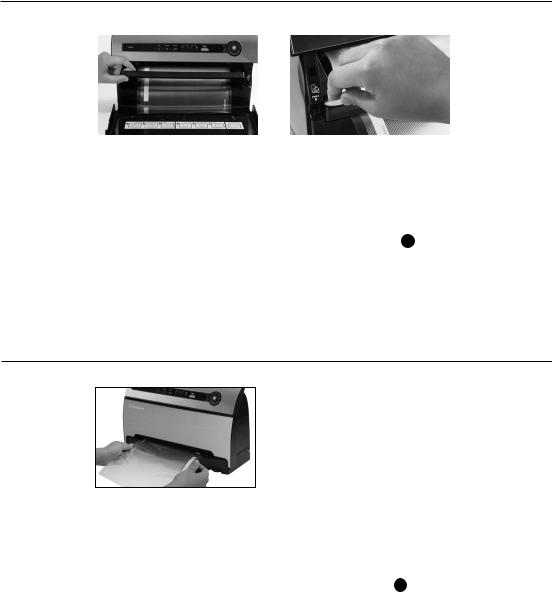
Come fare un sacchetto da un rotolo di sigillatura sottovuoto Foodsaver®
SOLLEVAMENTO DEL |
|
SCIVOLAMENTO DEL |
COLTELLO DEL ROTOLO |
|
COLTELLO |
|
|
|
|
|
|
Fig. 1
1.Aprire lo sportello dell’apparecchio nel compartimento di conservazione del rotolo (K). Per ottenere migliori risultati , inserire il rotolo con il materiale rivolto in basso. Nota: i sacchetti possono essere sigillati con lo sportello dell’apparecchio chiuso o aperto.
2.Sollevare verso l’alto la barra del taglierino del rotolo
(H) e porre il materiale sotto la barra del coltello
(Vedere la figura.1).
3.Fare uscire il foglio per una lunghezza sufficiente per mantenere l’articolo conservato sottovuoto, più 4 pollici ( 11 cm). Abbassare la barra del coltello e far scivolare il coltello del rotolo (H) lungo la barra
(Vedere la figura.2).
Fig. 2
4.Premere il pulsante di sigillatura (C). La spia rossa di sigillatura si accende.
5.Usando le due mani, inserire un lato aperto del sacchetto nel canale di aspirazione (E), fino a che il motore di chiusura si avvia. Il sacchetto deve essere centrato tra le frecce.
6.Quando la spia rossa 10 di sigillatura si spegne, il processo di sigillatura è completato. Ora si può
rimuovere il sacchetto dal canale di aspirazione (E).
7.Si dispone di un lato sigillato.
8.Ora si è pronti per una sigillatura sottovuoto con il nuovo sacchetto (Vedere qui di seguito).
Come sigillare sottovuoto i sacchetti Foodsaver®
INSERZIONE DEL SACCHETTO
Fig. 3
1.Iniziare con un sacchetto del sistema si sigillatura sottovuoto FoodSaver® (o creare un sacchetto come descritto nella sezione precedente “Come fare un sacchetto da un rotolo”).
2.Porre l’alimento nel sacchetto, lasciando almeno 8 cm (3 pollici) di spazio tra il contenuto e la parte superiore del sacchetto.
3.Usando le due mani, inserire il lato aperto del sacchetto nel canale di aspirazione (E), fino a che il motore di chiusura si avvia (vedere la figura 3). La spia della progressione dell’aspirazione si accende.
4.Continuare a mantenere il sacchetto fino al momento che la pompa di aspirazione si avvia. Ora si può lasciare il sacchetto. Nota: per evitare lo schiacciamento di alimenti delicati, si può premere il pulsante di sigillatura (C) in qualsiasi momento per iniziare il processo automatico di sigillatura.
5.Quando la luce rossa 10 si spegne, rimuovere il sacchetto. Conservare in frigorifero o nel congelatore, se necessario. (Vedere la sezione dei consigli di sicurezza) Nota: Attendere almeno 20 secondi tra ogni sigillatura per permettere all’apparecchio di raffreddarsi bene.
6 |
www.foodsavereurope.com |

Linee direttive per la conservazione sottovuoto
Confezionamento sottovuoto e sicurezza degli alimenti
Il confezionamento sottovuoto prolunga la vita degli alimenti, poiché elimina la maggior parte dell’aria dal contenitore ermetico e riduce l’ossidazione che incide sul valore nutritivo, sul sapore e sulla qualità generale dei cibi. L’eliminazione dell’aria inibisce inoltre il proliferare di microrganismi che possono causare
problemi in specifiche circostanze:
Muffa – Facilmente identificabile per il suo aspetto vellutato. La muffa non cresce in ambienti dal basso contenuto di ossigeno e quindi il confezionamento sottovuoto ne rallenta la formazione.
Lievito – Produce fermentazione, ravvisabile da un odore acre e un sapore cattivo. Il lievito si forma in presenza di acqua, zucchero e a temperatura
moderata e può anche sopravvivere in assenza d’aria. La refrigerazione rallenta la crescita di lievito; il congelamento la inibisce del tutto.
Batteri – Producono un odore sgradevole, causano scolorimento e/o rivestono il prodotto con una patina viscida. In condizioni propizie, il clostridium botulinum (l’organismo che causa il botulismo)
si può formare in assenza d’aria e non è sempre avvertibile dall’olfatto o dal gusto. Benché molto raro, il botulismo è assai pericoloso.
Per la conservazione sicura degli alimenti, è importante mantenerli a bassa temperatura. La crescita batterica si riduce considerevolmente a temperature di 4ºC e inferiori. Il congelamento a - 17ºC non neutralizza i microrganismi ma ne arresta la crescita. Per la conservazione nel lungo periodo, surgelare sempre i cibi deteriorabili che sono stati confezionati sottovuoto, e tenerli in frigorifero dopo averli scongelati. È importante osservare che il confezionamento sottovuoto NON è un’alternativa all’inscatolamento e non inverte il deterioramento dei prodotti alimentari, ma può solo rallentare la perdita di qualità. È difficile prevedere la durata dei cibi al livello di qualità massima, ciò dipende dall’età e dalle condizioni di ogni prodotto quando viene sigillato sottovuoto.
IMPORTANTE: Il confezionamento sottovuoto NON è un’alternativa alla refrigerazione o al congelamento.
Qualsiasi prodotto alimentare deteriorabile da tenere in frigorifero deve essere refrigerato o surgelato dopo il confezionamento sottovuoto.
Suggerimenti per la preparazione dei cibi e per il riscaldamento
Scongelamento e riscaldamento di prodotti alimentari confezionati sottovuoto
Scongelare sempre i prodotti in frigorifero o nel forno a microonde; non scongelare i cibi deteriorabili a temperatura ambiente.
Per riscaldare i cibi in una busta FoodSaver® con un forno a microonde, aprire sempre un angolo della busta prima di posarla sul piatto del microonde. Per
evitare la concentrazione di calore in alcuni punti, non riscaldare al microonde carni con l’osso o cibi grassi utilizzando le buste FoodSaver®. È anche possibile riscaldare i cibi nelle buste FoodSaver® a bagnomaria (al di sotto di 75°C).
Istruzioni per la preparazione di carne e pesce:
Per i migliori risultati, precongelare carni e pesce per 1-2 ore prima di confezionare questi prodotti sottovuoto in una busta FoodSaver®. In tal modo si
conservano i succhi e la forma dei prodotti alimentari, e si assicura una sigillazione ottimale.
Se non è possibile precongelarli, inserire un pezzo di carta da cucina sopra il prodotto, appena sotto l’area di sigillazione. Lasciare la carta nella busta in modo che assorba l’umidità eccessiva e i succhi durante il confezionamento sottovuoto.
NB: La carne di manzo può avere un colore più scuro dopo il confezionamento sottovuoto, a causa della rimozione dell’ossigeno. Ciò non indica che il prodotto è avariato..
Instruzioni per la preparazione di formaggi a pasta dura:
Per la freschezza dei formaggi, riconfezionarli sottovuoto dopo ogni uso. La busta FoodSaver® deve essere particolarmente lunga, con 2,5 cm di materiale supplementare per ogni volta che si prevede di aprire e risigillare la busta, oltre allo spazio di 7,5 cm da lasciare normalmente tra il prodotto e la chiusura. Tagliare il bordo sigillato e togliere il formaggio. Per riporlo in conservazione, richiudere la busta e risigillarla.
IMPORTANTE: I formaggi a pasta molle non devono mai essere confezionati sottovuoto.
Istruzioni per la preparazione di verdure:
Le verdure devono essere scottate prima del confezionamento sottovuoto. Ciò arresta il processo enzimatico che deteriora il sapore, il colore e la consistenza delle verdure.
Per la scottatura, versare le verdure in acqua bollente o utilizzare un forno a microonde, assicurando
che rimangano comunque croccanti. I tempi per la scottatura variano da 1 a 2 minuti per le verdure a foglia verde e i piselli, da 3 a 4 minuti per taccole (piselli dolci), zucchine a fette e broccoli; 5 minuti per le carote; da 7 a 11 per le pannocchie di granoturco. Dopo la scottatura, immergere le verdure in acqua fredda per arrestarne la cottura. Infine, asciugarle amponandole con un canovaccio prima del confezionamento sottovuoto.
NB: tutte le verdure (compresi broccoli, cavolini di Bruxelles, cavolo, cavolfiore, cavolo riccio, rapa) emanano gas naturali durante la conservazione. Dopo la scottatura, devono dunque essere conservati unicamente in freezer.
Quando si congelano le verdure, si consiglia di presurgelarle per 1-2 ore o finché non appaiono dure al tatto. Per congelare le verdure in porzioni singole, spargerle su una teglia da forno in modo che non si sovrappongano. In questo modo se ne
www.foodsavereurope.com |
7 |

Linee direttive per la conservazione sottovuoto
impedisce il congelamento in blocco. Dopo averle congelate, toglierle dalla teglia e chiuderle sottovuoto in una busta FoodSaver®. Dopo il confezionamento sottovuoto, riporle nuovamente nel freezer.
IMPORTANTE: a causa del rischio di batteri anaerobici, i funghi freschi, le cipolle e l’aglio non devono mai essere confezionati sottovuoto.
Istruzioni per la preparazione di verdure in foglia:
Per i migliori risultati, utilizzare un contenitore per le verdure in foglia. Lavare le verdure, quindi asciugarle con un canovaccio o in una centrifuga per insalata.
Dopo averle asciugate, riporle in un contenitore e confezionarle sottovuoto. Conservarle in frigorifero.
Istruzioni per la preparazione della frutta:
Quando si congelano frutti molli o frutti di bosco, si consiglia di presurgelarli per 1-2 ore o finché non appaiono duri al tatto. Per congelare la frutta in porzioni singole, spargerla su una teglia da forno in modo che i singoli frutti non si sovrappongano. In questo modo se ne impedisce il congelamento in
blocco. Dopo averla congelata, toglierla dalla teglia e chiuderla sottovuoto in una busta FoodSaver®. Dopo il confezionamento sottovuoto, riporla nuovamente nel freezer.
È possibile creare porzioni sottovuoto per l’uso nella preparazione di torte oppure per l’aggiunta alla macedonia. In questo modo la frutta è disponibile tutto l’anno. Per la conservazione in frigorifero, si consiglia l’uso di contenitori FoodSaver®.
Istruzioni per la preparazione di prodotti da forno:
Per confezionare sottovuoto prodotti da forno morbidi e gonfi, si consiglia di utilizzare un contenitore FoodSaver® che non ne schiaccia la forma. Se si usa una busta, presurgelare i prodotti per 1-2 ore o finché non appaiono duri al tatto. Per velocizzare i tempi, creare la pasta per torte e biscotti, i fondi delle torte o torte complete o premescolare gli ingredienti asciutti e confezionarli sottovuoto per l’uso futuro.
Istruzioni per la preparazione di caffè e prodotti farinosi:
Per impedire l’infiltrazione di piccole particelle di cibo nella pompa del sottovuoto, porre un pezzo di carta da cucina sopra il prodotto nella confezione o nella busta prima di applicare il sottovuoto. È anche possibile riporre l’alimento nella confezione originale all’interno di una busta FoodSaver® o utilizzare un coperchio universale FoodSaverT® con il contenitore originale per il confezionamento sottovuoto.
Istruzioni per la preparazione di liquidi:
brodo per minestra, presurgelarlo in una casseruola, una marmitta o nel vassoio dei cubetti di ghiaccio. Togliere il liquidi congelato e confezionarlo sottovuoto in una busta FoodSaver®. I cubetti di brodo congelati sono facilmente impilabili nel freezer. Per utilizzarli, sarà sufficiente tagliare un angolo della busta e
collocare la busta nel forno a microonde oppure in acqua a bassa ebollizione (al di sotto di 75°C).
Per conservare sottovuoto liquidi in bottiglia non efervescenti, si può usare un tappo FoodSaver® con il contenitore originale. Ricordarsi di lasciare almeno 2,5 cm (1 pollice) di spazio tra il contenuto e il fondo del tappo. Le bottiglie possono essere risigillate dopo ogni uso.
Linee guida per la preparazione per cibi preparati in anticipo, resti e sandwich:
Si conservano efficacemente i cibi preparati in anticipo, i resti e i sandwich nei contenitori leggeri, impilabili FoodSaver®. Essi possono essere passati nel forno a microonde o lavati nel cestello superiore della lavatrice e forniti con un adattatore regolabile. I contenitori leggeri saranno pronti per essere portati in ufficio o a scuola o dovunque!
Linee guida per la preparazione di spuntini:
I vostri spuntini rimarranno freschi più a lungo se li conserverete sottovuoto. Per migliori risultati utilizzate un barattolo o un container della gamma FoodSaver® per gli alimenti fragili come i crackers.
Conservazione sottovuoto di articoli non alimentari
Il sistema di conservazione sottovuoto FoodSaver® protegge anche articoli non alimentari dall’ossidazione, la corrosione e l’umidità. Basta
seguire le istruzioni per la conservazione sottovuoto degli alimenti usando scatole, contenitori e accessori FoodSaver®.
Per conservare sottovuoto posate in argento, inserirle in un materiale di imbottitura, come tovaglioli di carta, per evitare di forare il sacchetto. I sacchetti FoodSaver® sono ideali per le escursioni all’aperto. Per il campeggio e le escursioni, si possono portare
i fiammiferi, le mappe e il cibo asciutto e compatto. Per avere acqua fresca da bere, riempire un sacchetto FoodSaver® con ghiaccio, sigillarlo e, quando necessario, lasciare che il ghiacciolo fonda. Se si fanno gite in barca a vela o in motoscafo, si può conservare sottovuoto il proprio cibo, le pellicole e un ricambio asciutto di vestiti. Ricordare di portare delle forbici o un coltello per aprire il sacchetto. Per mantenere i kit di emergenza al sicuro e asciutti, conservare sottovuoto segnali luminosi, batterie, torce elettriche, fiammiferi e candele e altri oggetti necessari. Gli articoli di emergenza resteranno asciutti e in ordine in casa, in macchina o in barca.
8 |
www.foodsavereurope.com |

Consigli per la riuscita di una sigillatura sottovuoto
Suggerimenti di carattere generale
Consigli per riuscita di una sigillatura sottovuoto
1.La sigillatura sottovuoto NON è un sostituto del processo di riscaldamento dei cibi in scatola. Gli alimenti deperibili devono essere refrigerati o congelati.
2.Per i migliori risultati, usare sacchetti, scatole, contenitori o accessori FoodSaver®.
3.Durante il processo di sigillatura sottovuoto, piccoli quantitativi di liquido, molliche o particelle di alimenti possono essere inavvertitamente spinti nel vassoio di gocciolamento (O), intasando la pompa e danneggiando l’apparecchio.
Per impedire questo problema, seguire questi consigli:
a.Per gli alimenti umidi e succosi: congelarli prima ed evitare di riempire troppo i sacchetti. Si può anche porre un tovagliolo di carta ripiegato nella parte superiore del sacchetto e sotto l’area di sigillatura.
b.Per le minestre, le salse e i liquidi: congelarli prima ed evitare di riempire troppo i sacchetti. Oppure usare una scatola o un contenitore nel frigorifero.
c.Per gli alimenti in polvere o finemente granulati: evitare di riempire troppo i sacchetti o usare una scatola o un contenitore. Si può anche introdurre un filtro per il caffé o un tovagliolo di carta prima di confezionare sottovuoto.
d.Dopo ogni uso vuotare il vassoio di gocciolamento (N).
4.Per evitare un riempimento eccessivo, lasciare almeno 8 cm (3 pollici) tra il contenuto e la parte superiore del sacchetto. Quindi lasciare almeno un altro pollice di sacchetto per il momento in cui si vuole riusarlo.
5.Non creare le proprie costure per un sacchetto di marca FoodSaver®. I nostri sacchetti sono prodotti con una speciale giuntura laterale, che è sigillata lungo l’intero bordo esterno.
6.Per evitare rugosità quando si sigillano sottovuoto alimenti voluminosi, tirare delicatamente per appiattire il sacchetto quando esso viene inserito nel canale di aspirazione e tenerlo fino a che la pompa comincia a funzionare.
7.Se non si è sicuri che il sacchetto sia sigillato correttamente, sigillarlo di nuovo.
8.Quando si deve sigillare sottovuoto articoli con bordi taglienti (spaghetti non cotti, argenteria, ecc.), proteggere il sacchetto da forature avvolgete gli articoli in un materiale di imbottitura soffice come un
tovagliolo di carta. Si può anche usare una scatola o un contenitore invece del sacchetto.
9.Quando si usano accessori, ricordarsi di lasciare 2,5 cm (1 pollice) di spazio sulla parte superiore della scatola o del contenitore.
10.Per ottenere i migliori risultati, surgelare la frutta e scaldare la verdura prima della sigillatura sottovuoto. Fare riferimento alle linee guida della Sezione Confezionamento sottovuoto, per maggiori informazioni.
11.Se l’apparecchio non funziona o se il pulsante di sigillatura (C) lampeggia per segnalare un problema:
a.Controllare il cavo di alimentazione per vedere se è correttamente inserito in una presa elettrica.
b.Esaminare il cavo di alimentazione per controllare che non sia danneggiato.
c.Vedere se la presa elettrica funziona, inserendo un altro apparecchio.
d.Controllare per assicurarsi che il vassoio superiore di rilevazione del sacchetto (O) sia correttamente inserito.
e.Assicurarsi che il sacchetto sia inserito correttamente nel canale di aspirazione (E). (Vedere Come sigillare sottovuoto con i sacchetti FoodSaver®)
f.Controllare per assicurarsi che il pulsante di rilascio (J) sia correttamente scattato.
g.Controllare la guarnizione in spugna (L) intorno al vassoio di gocciolamento, per assicurarsi che non vi sia cibo o materiali e che essa sia correttamente inserita nel relativo canale.
h.Controllare la guarnizione superiore (P) intorno al vassoio di rilevazione del sacchetto superiore (O) per assicurarsi che non vi sia presenza di cibo o materiali.
i.Se l’apparecchio è surriscaldato, lasciarlo riposare 20 minuti.
j.Per ulteriori consigli sul funzionamento, visitare il nostro sito web al www.foodsavereurope.com.
Consigli per rimuovere l’aria dal sacchetto
Consigli per rimuovere l’aria dal sacchetto (E).
Rugosità nella sigillatura possono causare perdite e lasciare che l’aria ritorni nel sacchetto. Per eliminare qualsiasi rugosità, inserire il sacchetto nel canale di aspirazione (E), tenere il sacchetto delicatamente con le due mani, stirandolo delicatamente per farlo divenire piatto fino a che sia attivata la pompa di aspirazione. Se si notano delle rugosità dopo aver sigillato il sacchetto, aprire quest’ultimo e ripetere la sigillatura sottovuoto.
Se il motore funziona per più di 30 secondi senza arrestarsi, considerare quanto segue:
Se si sta sigillando sottovuoto con un sacchetto, assicurarsi che quest’ultimo sia correttamente sigillato (Vedere “Come fare un sacchetto da un rotolo”). Controllare la guarnizione di schiuma intorno al vassoio di gocciolamento, per assicurarsi che esso sia vuoto di alimenti e che sia correttamente inserito nel canale della guarnizione.
Se si sta sigillando sottovuoto con un accessorio, controllare le connessioni del tubo flessibile dell’accessorio, per assicurare una stretta corrispondenza.
www.foodsavereurope.com |
9 |

Consigli per la riuscita di una sigillatura sottovuoto (continua)
Consigli per sigillare un sacchetto
Quando si fa un sacchetto da un rotolo:
Premere il pulsante di sigillatura (C) prima di inserire il sacchetto nel canale di aspirazione (E). Una volta inserito il sacchetto, il processo di sigillatura inizia immediatamente. Nota: se si dimentica di premere il pulsante di sigillatura
(C) prima di inserire il sacchetto nel canale di aspirazione (E), la pompa di aspirazione si attiva, creando un problema, basta allora premere il pulsante di sigillatura, per impedire alla pompa di funzionare continuamente e iniziare il processo di sigillatura.
Come impedire all’umidità e ai liquidi di essere spinti nel vassoio di gocciolamento (N) o di restare intrappolati nella sigillatura:
Precongelare l’alimento umido come la carne cruda per 1-2 ore prima della sigillatura sottovuoto o porre un tovagliolo di carta tra il cibo e l’estremità del sacchetto, per assorbire i liquidi in eccesso. Assicurarsi di lasciare almeno 8 cm (3 pollici) tra il tovagliolo di carta e l’estremità del sacchetto, in modo che quest’ultimo possa essere sigillato correttamente col tovagliolo di carta all’interno e non sia posto in mezzo dell’area di sigillatura.
Assicurarsi che l’apparecchio abbia il tempo di raffreddarsi.
Attendere almeno 20 secondi tra le sigillature. In condizioni di uso molto gravose, l’apparecchio arresta il funzionamento per impedire il surriscaldamento. Se questo avviene, attendere 20 minuti per permettere all’apparecchio di raffreddarsi.
Consigli sulla sigillatura sottovuoto con accessori
Come preparare gli accessori FoodSaver® per il confezionamento sottovuoto
Gli accessori includono le scatole di confezionamento sottovuoto FoodSavor, i contenitori e i tappi delle bottiglie.
1.Lasciare almeno 2,5 cm (1 pollice) di spazio tra il contenuto e il bordo.
2.Strofinare il bordo della scatola, del contenitore o della bottiglia per assicurarsi che sia pulito e asciutto.
3.Porre il coperchio sulla scatola o sul contenitore o porre il tappo sulla bottiglia.
4.Per gli accessori con un grande pomello sul coperchio, girare il pomello per aspirare. Confezionare sottovuoto seguendo le istruzioni qui di seguito. Quando il processo di aspirazione è completato, girare il pomello in posizione di chiuso prima di rimuovere il tubo flessibile dell’accessorio.
5.Per gli accessori con un grande pomello sul coperchio, confezionare sottovuoto, seguendo le istruzioni seguenti.
Marinatura con l’apparecchio FoodSaver®
Il sistema di sigillatura sottovuoto FoodSaver® ha un ciclo speciale di marinatura rapida della durata di circa 10 minuti. Il motore di aspirazione manterrà il vuoto per diversi minuti, quindi lo rilascerà, consentendo al cibo di riposare per 30 secondi. Questo processo viene quindi ripetuto per due altre volte. Questa azione “alternata” di “aspirazione e riposo” consente una marinatura rapida.
Quando il ciclo di marinatura rapida è completato, l’apparecchio emetterà un segnale acustico per avvisare che la marinatura è completata. La scatola di marinatura rapida FoodSaver è il perfetto accessorio FoodSaver® per marinare gli alimenti. Questi si possono marinare
in pochi minuti con la sigillatura sottovuoto, perché il processo di aspirazione apre i pori degli alimenti e assorbe la marinatura più rapidamente.
Nota importante: usare la scatola di marinatura rapida FoodSaver® con un coperchio chiaro e un grande pomello bianco. Durante il ciclo di marinatura rapida, assicurarsi che il pomello sul coperchio dell’accessorio sia regolato su APERTO. La posizione di aspirazione sul pomello consentirà alla scatola di marinatura rapida di essere usata per un periodo prolungato di conservazione.
1.Preparare una quantità di marinata, sufficiente a coprire interamente il cibo in una scatola di
marinatura. Lasciare sempre almeno 2,5 cm (1 pollice) tra il contenuto e la parte superiore del bordo.
2.Assicurarsi che la guarnizione a forma di nastro si trovi sotto il coperchio e il bordo della scatola di marinatura sia libero di materiale alimentare.
3.Assicurarsi che il tubo flessibile dell’accessorio sia inserito saldamente nello sportello del coperchio di marinatura FoodSaver®.
4.Assicurarsi che il pomello sul coperchio dell’accessorio sia impostato su APERTO.
5.Assicurarsi che il coperchio sia saldamente attaccato alla base del recipiente di marinatura.
6.Premere il pulsante Marinatura sul pannello di controllo.
7.Ora, il sistema di sigillatura sottovuoto FoodSaver® inizia il ciclo di marinatura rapida. La spia di marinatura lampeggia per indicare che il processo di marinatura è iniziato.
8.Durante il ciclo iniziale di aspirazione, l’indicatore della modalità di marinatura si accende. Durante la marinatura, il display del progresso di aspirazione lampeggia durante l’aspirazione o il ciclo di riposo.
9.Per conservare gli alimenti in condizioni di sicurezza, dopo aver completato il ciclo di marinatura, l’apparecchio segnalerà con brevi segnali acustici che il ciclo rapido di marinatura è completato. Premere qualsiasi pulsante per silenziare il segnale acustico. Ora si può cuocere o mettere in frigorifero il cibo marinato.
10 |
www.foodsavereurope.com |

Guida per la conservazione degli alimenti | Carni, formaggi, verdure, frutta
|
|
Busta/accessorio |
Durata di |
Durata di |
|
Luogo di |
FoodSaver® |
conservazione |
conservazione |
Alimenti |
conservazione |
consigliato |
FoodSaver® |
normale |
Carne |
|
|
|
|
|
|
|
|
|
Rinforzi, maiale, agnello |
Freezer |
FoodSaver® Busta |
2-3 anni |
6 mesi |
Carne macinata |
Freezer |
FoodSaver® Busta |
1 anni |
4 mesi |
Pollame |
Freezer |
FoodSaver® Busta |
2-3 anni |
6 mesi |
Pesce |
Freezer |
FoodSaver® Busta |
2 anni |
6 mesi |
Formaggi a pasta dura ( Non confezionare sottovuoto formaggi a pasta molle ) |
|
|||
|
|
|
|
|
Formaggio cheddar |
Frigorifero |
FoodSaver® Busta, |
4-8 mesi |
1-2 settimane |
|
|
Contenitore |
|
|
|
|
|
|
|
Parmigiano |
Frigorifero |
FoodSaver® Busta, |
4-8 mesi |
1-2 settimane |
|
|
Contenitore |
|
|
|
|
|
||
Verdure ( Non confezionare sottovuoto funghi freschi, cipolle e aglio ) |
|
|
||
|
|
|
|
|
Asparagi |
Freezer |
FoodSaver® Busta |
2-3 anni |
8 mesi |
Broccoli, cavolfiore |
Freezer |
FoodSaver® Busta |
2-3 anni |
8 mesi |
Cavolo, cavolini di |
Freezer |
FoodSaver® Busta |
2-3 anni |
8 mesi |
Bruxelles |
|
|
|
|
|
|
|
|
|
Mais (pannocchie o in |
Freezer |
FoodSaver® Busta |
2-3 anni |
8 mesi |
grani) |
|
|
|
|
|
|
|
|
|
Fagiolini |
Freezer |
FoodSaver® Busta |
2-3 anni |
8 mesi |
Lattuga, spinaci |
Frigorifero |
FoodSaver® Contenitore |
2 settimane |
3-6 giorni |
Pisellini, taccole |
Freezer |
FoodSaver® Busta |
2-3 anni |
8 mesi |
Frutta |
|
|
|
|
|
|
|
|
|
Albicocche, prugne |
Freezer |
FoodSaver® Busta |
1-3 anni |
6-12 messi |
Pesche, pesche noce |
Freezer |
FoodSaver® Busta |
1-3 anni |
6-12 messi |
Frutti di bosco teneri |
|
|
|
|
|
|
|
|
|
Lamponi, more |
Frigorifero |
FoodSaver® Contenitore |
1 settimane |
1-3 giorni |
Fragole |
Frigorifero |
FoodSaver® Contenitore |
1 settimane |
1-3 giorni |
Frutti di bosco sodi |
|
|
|
|
|
|
|
|
|
Mirtilli |
Frigorifero |
FoodSaver® Contenitore |
2 settimane |
3-6 giorni |
Mirtilli rossi |
Frigorifero |
FoodSaver® Contenitore |
2 settimane |
3-6 giorni |
www.foodsavereurope.com |
11 |

Pane, caffè, snacks e liquidi
|
|
Busta/accessorio |
Durata di |
Durata di |
|
Luogo di |
FoodSaver® |
conservazione |
conservazione |
Alimenti |
conservazione |
consigliato |
FoodSaver® |
normale |
Prodotti da forno |
|
|
|
|
|
|
|
|
|
Panini, Bread, |
Freezer |
FoodSaver® Busta |
1-3 anni |
6-12 mesi |
pasticcini |
|
|
|
|
|
|
|
|
|
Frutta secca |
|
|
|
|
|
|
|
|
|
Mandorle, |
Dispensa |
FoodSaver® Busta, Contenitore |
2 anni |
6 mesi |
arachidi |
|
|
|
|
|
|
|
|
|
Semi di |
Dispensa |
FoodSaver® Busta, Contenitore |
2 anni |
6 mesi |
girasole |
|
|
|
|
|
|
|
|
|
Caffè |
|
|
|
|
|
|
|
|
|
Chicchi |
Freezer |
FoodSaver® Busta |
2-3 anni |
6 mesi |
Chicchi |
Dispensa |
FoodSaver® Busta, Contenitore |
1 anni |
3 mesi |
Macinato |
Freezer |
FoodSaver® Busta |
2 anni |
6 mesi |
Macinato |
Dispensa |
FoodSaver® Busta, Contenitore |
5-6 mesi |
1 mesi |
Prodotti liquidi |
|
|
|
|
|
|
|
|
|
Sughi, |
Freezer |
FoodSaver® Busta |
1-2 anni |
3-6 mesi |
minestre, bolliti |
|
|
|
|
|
|
|
|
|
Liquidi in bottiglia |
|
|
|
|
|
|
|
|
|
Oli |
Dispensa |
FoodSaver® Tappo di bottigla |
1-11⁄2 anni |
5-6 mesi |
Prodotti secchi |
|
|
|
|
|
|
|
|
|
Fagioli, cereali |
Dispensa |
FoodSaver® Busta, Contenitore |
1-2 anni |
6 mesi |
Pasta, riso |
Dispensa |
FoodSaver® Busta, Contenitore |
1-2 anni |
6 mesi |
Prodotti farinosi |
|
|
|
|
|
|
|
|
|
Latte in polvere |
Dispensa |
FoodSaver® Busta, Contenitore |
1-2 anni |
6 mesi |
Cocco essiccato |
Dispensa |
FoodSaver® Busta, Contenitore |
1-2 anni |
6 mesi |
Farina |
Dispensa |
FoodSaver® Busta, Contenitore |
1-2 anni |
6 mesi |
Zucchero, |
Dispensa |
FoodSaver® Busta, Contenitore |
1-2 anni |
6 mesi |
zucchero |
|
|
|
|
greggio |
|
|
|
|
|
|
|
|
|
Spuntini |
|
|
|
|
|
|
|
|
|
Patatine |
Dispensa |
FoodSaver® Contenitore |
3-6 settimane |
1-2 settimane |
Biscotti, cracker |
Dispensa |
FoodSaver® Contenitore |
3-6 settimane |
1-2 settimane |
12 |
www.foodsavereurope.com |
